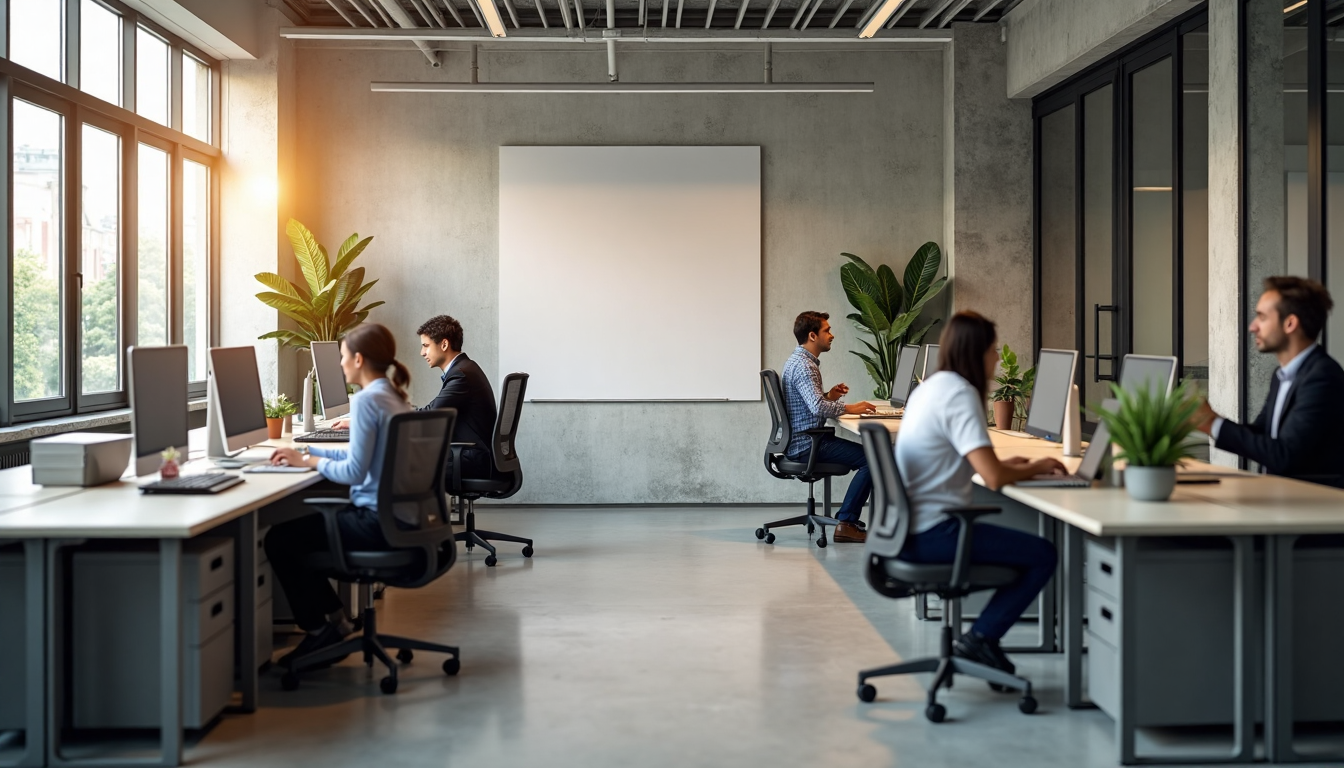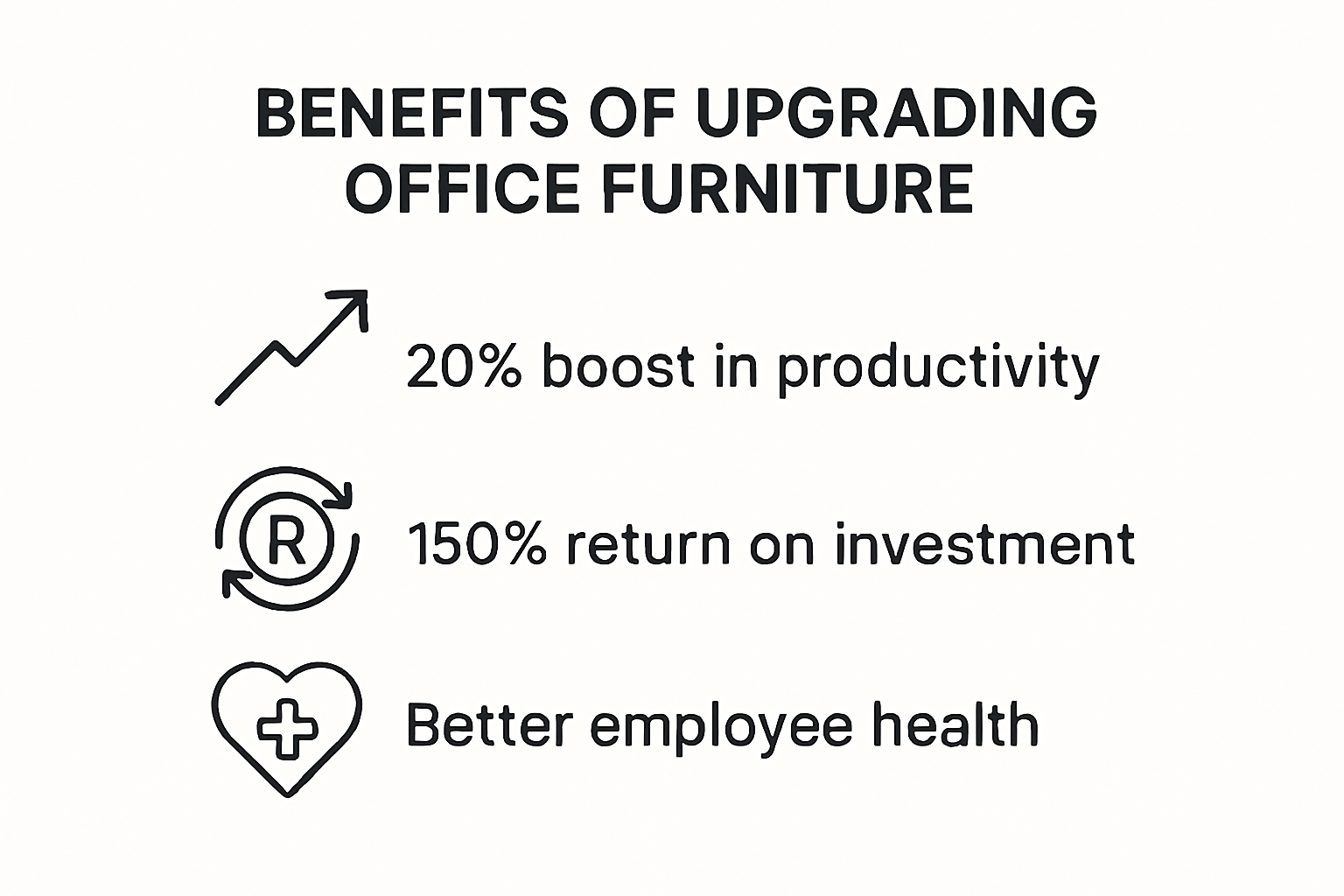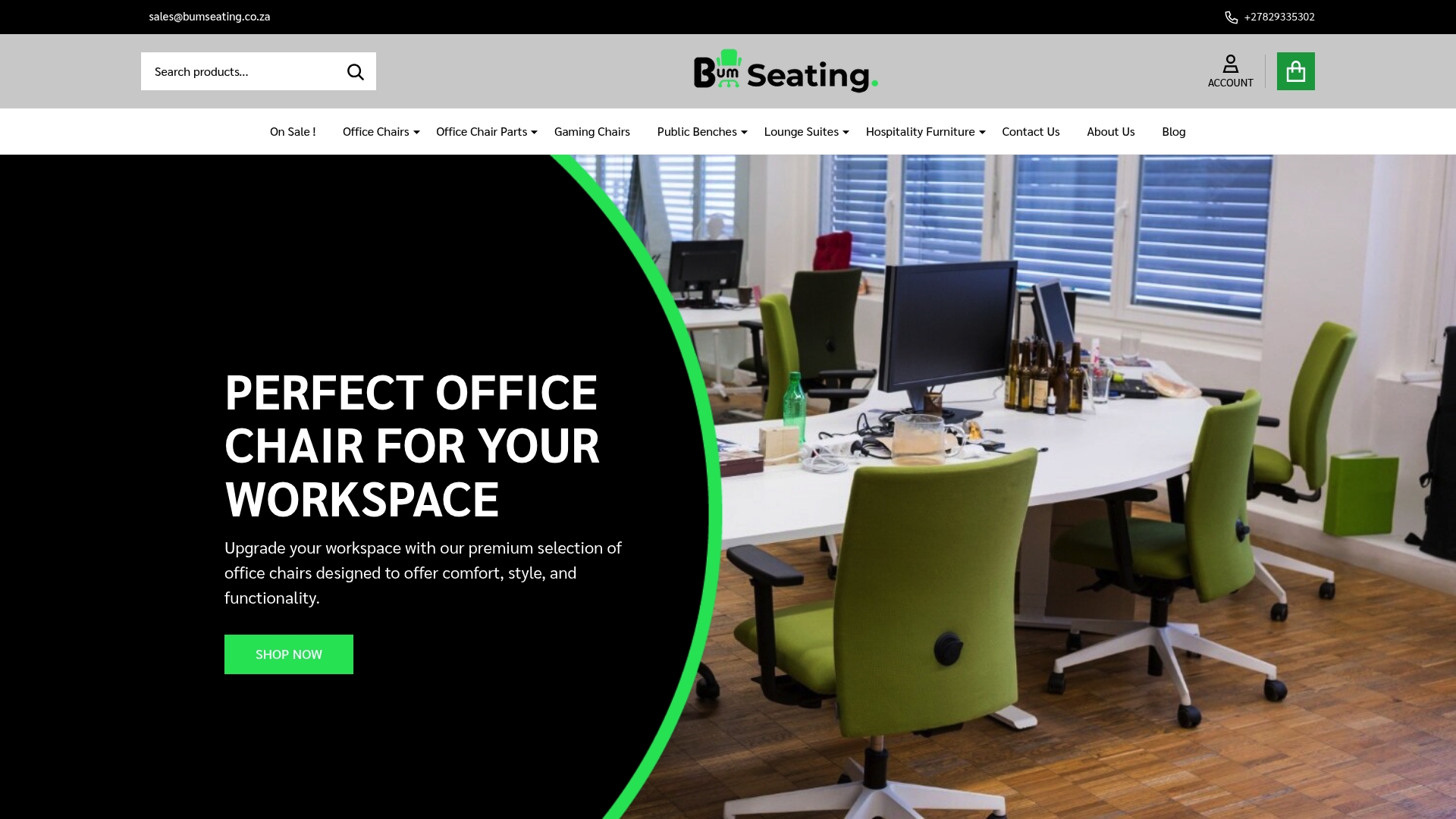Upgrading Your Office Furniture: Smart Choices for 2025
5th Jul 2025
Upgrading Your Office Furniture: Smart Choices for 2025

Office upgrades are on everyone’s mind for 2025 and it is not just about picking a chair that matches the curtains. Here is a shocker. Upgrading to ergonomic furniture can raise productivity by 10 to 15 percent and save up to six times your investment just through fewer sick days and injuries. Most would think fancy gadgets or décor matter most but the truth is this. The real edge comes from investing in the health and comfort of your team, not just what looks good on a Zoom call.
Table of Contents
- Key Reasons For Upgrading Your Office Furniture
- How To Choose The Right Furniture Solutions
- Budgeting And Planning For Your Office Upgrade
- South African Trends In Office Furniture 2025
Quick Summary
| Takeaway | Explanation |
|---|---|
| Enhance Employee Health with Ergonomic Furniture | Investing in ergonomic office furniture can significantly reduce the risk of musculoskeletal disorders and boost productivity by 10% to 15%. Proper seating is critical for long hours at workstations. |
| Strategic Investment Yields High Returns | For every rand spent on ergonomic furniture, organizations can potentially save up to six times that amount due to reduced absenteeism and workplace injuries, emphasizing the economic rationale for upgrades. |
| Adaptable Furniture for Future Workspaces | Modular and multi-functional furniture is essential in accommodating hybrid work models, allowing easy reconfiguration for various work styles and enhancing overall workplace adaptability. |
| Sustainable Choices Reflect Corporate Values | Emphasizing environmentally responsible furniture made from recycled or renewable materials appeals to a conscientious workforce and demonstrates corporate responsibility. |
| Employee Well-Being as a Design Focus | Investing in smart furniture and ergonomic solutions enhances employee comfort and health, fostering a productive and supportive work environment. |

Key Reasons for Upgrading Your Office Furniture
Upgrading your office furniture is more than a cosmetic decision. It represents a strategic investment in workplace productivity, employee health, and overall organizational performance. Modern businesses recognize that the physical environment directly impacts workforce efficiency, employee satisfaction, and long-term operational success.
Enhancing Employee Health and Productivity
Workplace design experts emphasize the critical importance of ergonomic considerations when choosing office furniture. Ergonomic solutions are not one-size-fits-all. Each workspace demands a tailored approach that considers individual employee needs, job requirements, and physical work environments.
Key ergonomic elements to prioritize include adjustable chair heights, lumbar support, proper seat depth, and flexible armrests. Office interior specialists recommend conducting individual assessments to understand specific employee requirements. This might involve measuring desk heights, evaluating typical work postures, and considering the range of physical movements performed during daily tasks.

Financial and Organizational Benefits
The economic rationale for upgrading office furniture extends beyond immediate comfort. Comprehensive cost-benefit analyses demonstrate a remarkable return on investment. For every rand spent on ergonomic furniture, organizations can potentially save up to six times that amount through reduced absenteeism, decreased workplace injuries, and increased productivity.
Furthermore, modern office furniture reflects an organization’s commitment to employee well-being. It signals to current and potential employees that the company values their health, comfort, and professional experience. This perception can significantly impact talent attraction and retention strategies.
Long-Term Strategic Considerations
Upgrading office furniture is a forward-looking decision that anticipates evolving workplace dynamics. With increasing remote and hybrid work models, office spaces must adapt to become more flexible and accommodating. Modular furniture, adjustable workstations, and multipurpose seating solutions are no longer optional but essential for creating adaptive work environments.
Consider our comprehensive guide on workspace design to understand how strategic furniture choices can transform your workplace. The right furniture does more than fill a space. It creates an environment that supports collaboration, creativity, and employee well-being.
As businesses continue to evolve, so must their physical workspaces. Upgrading your office furniture is not just about replacing old items. It is about making a strategic investment in your most valuable asset: your people.
Here is a summary table outlining the key strategic and organizational benefits of upgrading office furniture, as discussed in this section:
| Benefit Area | Impact |
|---|---|
| Employee Health & Productivity | Reduction in musculoskeletal disorders; productivity gains of 10–15% |
| Financial Savings | Up to 6x return on investment through reduced absenteeism and injuries |
| Talent Attraction & Retention | Modern furniture signals company values, enhancing appeal to employees |
| Flexibility for Hybrid Work | Modular, adaptive furniture meets changing work models |
| Enhanced Collaboration & Well-being | Spaces designed for comfort foster teamwork and satisfaction |
How to Choose the Right Furniture Solutions
Selecting the right office furniture requires a strategic approach that balances functionality, comfort, and aesthetic considerations. The process goes beyond simple visual appeal, demanding careful evaluation of multiple factors that impact workplace performance and employee well-being.
Assessing Ergonomic Requirements
Workplace design experts emphasize the critical importance of ergonomic considerations when choosing office furniture. Ergonomic solutions are not one-size-fits-all. Each workspace demands a tailored approach that considers individual employee needs, job requirements, and physical work environments.
Key ergonomic elements to prioritize include adjustable chair heights, lumbar support, proper seat depth, and flexible armrests. Office interior specialists recommend conducting individual assessments to understand specific employee requirements. This might involve measuring desk heights, evaluating typical work postures, and considering the range of physical movements performed during daily tasks.
Material Durability and Quality Considerations
Office space planning consultants highlight the importance of selecting furniture constructed from high-quality, durable materials. Hardwood, metal, and premium plastics offer longevity and resistance to workplace wear and tear. When evaluating furniture solutions, consider factors such as:
- Structural integrity: Furniture that maintains its form and function under consistent use
- Material resilience: Resistance to scratches, stains, and daily workplace impacts
- Maintenance requirements: Ease of cleaning and potential long-term upkeep costs
Adaptability and Future-Proofing
Modern office furniture must accommodate evolving workplace dynamics. Workspace design research suggests investing in multi-functional furniture that supports flexible work arrangements. Modular designs that can be easily reconfigured provide significant advantages for businesses anticipating growth or organizational changes.
Consider furniture solutions that offer:
- Adjustable workstations
- Modular seating arrangements
- Integrated storage solutions
- Compatibility with technology infrastructure
The right furniture goes beyond immediate aesthetic preferences. It represents a strategic investment in workplace efficiency, employee comfort, and organizational adaptability. By carefully evaluating ergonomic requirements, material quality, and future flexibility, businesses can create work environments that support productivity and employee well-being.
Remember that furniture selection is not just about filling space. It is about creating an environment that empowers employees, reflects organizational culture, and supports ongoing business evolution.
Below is a table summarising the main criteria for selecting office furniture, as covered in this section:
| Criteria | Key Considerations |
|---|---|
| Ergonomics | Adjustable heights, lumbar support, custom fit for roles and individuals |
| Material Durability & Quality | Structural integrity, material resilience, low maintenance requirements |
| Adaptability & Future-Proofing | Modular designs, reconfigurability, tech compatibility, integrated storage |
Budgeting and Planning for Your Office Upgrade
Budgeting for an office furniture upgrade requires a strategic and comprehensive approach that balances financial constraints with workplace enhancement objectives. A well-planned upgrade can transform your workspace without causing financial strain, making careful preparation critical to success.
Establishing Clear Upgrade Objectives
Workspace design experts recommend defining precise objectives before allocating any financial resources. These objectives might include improving employee comfort, enhancing workplace aesthetics, optimizing spatial efficiency, or addressing specific ergonomic requirements. By crystallizing your goals, you create a focused framework that guides spending and prevents unnecessary expenditures.
Consider conducting an internal assessment to identify the most critical areas requiring investment. This might involve surveying employees about their current workspace challenges, analyzing productivity metrics, and evaluating existing furniture’s condition. Such a comprehensive approach ensures that your budget targets the most impactful improvements.
Financial Planning and Cost Management
Office design consultants advise establishing a realistic budget that accounts for both immediate and long-term expenses. A robust budgeting strategy should include:
- Comprehensive cost estimation: Include furniture prices, delivery, installation, and potential workspace modification expenses
- Contingency allocation: Reserve 10-15% of your total budget for unexpected costs
- Phased implementation: Consider upgrading furniture in stages to distribute financial impact
To maximize value, explore cost-effective alternatives such as modular furniture, which offers flexibility and potentially lower long-term expenses. Budget-conscious design strategies suggest considering refurbished or high-quality second-hand pieces that maintain professional standards while reducing initial investment.
Strategic Investment and Long-Term Considerations
Thinking beyond immediate costs requires evaluating the long-term value of your furniture investment. Workspace design research indicates that strategically chosen furniture can contribute to improved employee productivity, reduced health-related absenteeism, and enhanced organizational perception.
Prioritize investments in key areas that directly impact employee performance and well-being. This might mean allocating more budget to ergonomic chairs or adjustable workstations while finding cost-effective solutions for auxiliary furniture. Remember that quality should never be completely sacrificed for cost savings, especially in critical areas like seating and primary workstations.
Successful office furniture upgrades blend financial prudence with strategic vision. By carefully planning your budget, setting clear objectives, and focusing on long-term value, you can create a workspace that supports both employee needs and organizational goals. The right approach transforms furniture procurement from a mere expense into a meaningful investment in your company’s most valuable asset: its people.
South African Trends in Office Furniture 2025
The South African office furniture landscape is experiencing a transformative shift in 2025, driven by technological advancements, changing workplace dynamics, and a growing emphasis on employee well-being. These emerging trends reflect a sophisticated understanding of workspace design that goes beyond traditional aesthetic considerations.
Sustainability and Eco-Conscious Design
Design experts highlight a significant move towards environmentally responsible office solutions. South African businesses are increasingly prioritizing sustainable materials, energy-efficient designs, and eco-friendly manufacturing processes. This trend extends beyond mere environmental consciousness. Companies recognize that sustainable furniture choices demonstrate corporate responsibility and appeal to environmentally aware employees and clients.
Key sustainable design elements include:
- Furniture made from recycled or renewable materials
- Locally sourced production to reduce carbon footprint
- Modular designs that extend furniture lifecycle
- Furniture with minimal environmental impact during production and disposal
Flexible and Adaptive Workspace Solutions
Workplace design researchers emphasize the critical importance of adaptability in modern office environments. South African companies are investing in furniture that supports hybrid work models, allowing seamless transitions between individual and collaborative work spaces. This approach recognizes the evolving nature of work in the post-pandemic era.
Our comprehensive workspace guide demonstrates how adaptive furniture can transform workplace productivity. Multi-functional pieces that can be easily reconfigured are becoming standard, supporting various work styles and team configurations. Features like movable partitions, height-adjustable desks, and modular seating arrangements enable businesses to create dynamic, responsive work environments.
Employee Well-being and Ergonomic Innovations
Occupational health specialists emphasize a holistic approach to workplace design that prioritizes employee health and comfort. South African companies are investing in ergonomic furniture that goes beyond traditional considerations. Emerging trends include:
- Smart furniture with integrated wellness technologies
- Chairs and desks that promote active sitting and movement
- Biophilic design elements that connect workspace with natural environments
- Customizable ergonomic solutions that adapt to individual employee needs
These trends reflect a profound understanding that office furniture is not merely about filling space. It is about creating environments that support physical health, mental well-being, and organizational productivity. South African businesses are at the forefront of reimagining workspace design, transforming offices from static environments to dynamic, human-centric ecosystems.
As we move further into 2025, the convergence of technology, sustainability, and employee-focused design will continue to shape the future of office furniture. Companies that embrace these innovative approaches will be better positioned to attract top talent, enhance productivity, and create workspaces that truly support their most valuable asset: their people.
Frequently Asked Questions
What are the benefits of upgrading to ergonomic office furniture?
Upgrading to ergonomic office furniture can enhance employee health and productivity, reducing the risk of musculoskeletal disorders and increasing productivity by 10% to 15%.
How do I choose the right office furniture for my workspace?
Choosing the right office furniture requires assessing ergonomic needs, considering material durability, and ensuring adaptability for future workspace changes. Tailoring solutions to individual employee requirements is critical.
What should I prioritize when budgeting for office furniture upgrades?
When budgeting for office furniture upgrades, establish clear upgrade objectives, consider comprehensive cost estimation, and plan for potential unexpected expenses. Prioritize investments in areas that will have the most significant impact on employee performance and well-being.
What are current trends in office furniture for 2025 in South Africa?
Current trends in South African office furniture focus on sustainability, flexible workspace solutions, and employee well-being. This includes using eco-friendly materials, modular designs, and ergonomic innovations that support hybrid work models.
Transform Your Workspace with Ergonomic Solutions
Are you struggling with outdated chairs, aching backs, and a lack of flexible seating that holds your team back? The article highlighted that poor office setups can drain productivity and lead to expensive health issues for your team. Let us help you break the cycle by making your office healthier and more efficient. Explore how smart, future-ready seating can deliver true value for your staff and your business.

Now is the time to invest in change. See our full range of ergonomic and executive office chairs on Bum Seating and discover seating that matches the exact needs discussed in the article. From adjustable task chairs to stylish reception seating, our products are designed to improve well-being and workplace culture. Ready to upgrade? Visit our website and shop smart for 2025. Your team deserves comfort, and your business deserves results.
Recommended
- Office Chairs & Seating Solutions | Bum Seating South Africa
- Blog - Bum Seating
- Design Tips for Selecting Ergonomic Office Chairs - Bum Seating
- Creating a Winning Workspace: How Seating Affects Employee Performance - Bum Seating
- Tips for Choosing the Right Hospitality Furniture for Your Venue - Bum Seating
- Making a Lasting Impression: The Importance of Reception Sofas in Your Office - Bum Seating
